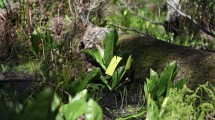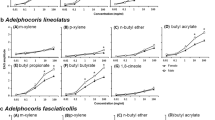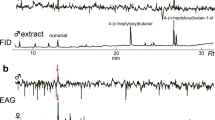Abstract
Cold-trapped carrot leaf volatiles were analyzed by gas chro-matography with an outlet splitter to a flame ionization detector and to a carrot fly antennogram preparation as the second detector (GC-EAD). Strongest EAD responses were elicited by products whose elution temperatures corresponded to the propenylbenzenes,trans-methylisoeugenol (3,4-dimethoxy-1-propenylbenzene) andtrans-asarone (2,4,5-trimethoxy-1-propenylbenzene) and, to a lesser extent, by-products matching the elution temperatures of the leaf aldehydes hexanal, (E)-2-hexenal, and heptanal, and of the terpenes linalool and caryophyllene. The identity of the propenylbenzenes was confirmed by gas chromatography-mass spectrom-etry. GC-EAD permitted accurate estimation of the olfactory thresholds; it was lowest fortrans-asarone at 500 attogram (5 × 10−16g)/ml of air passing over the antenna. Both the leaf aldehydes and propenylbenzenes were attractive when tested individually in the field with yellow sticky traps; fly captures were linearly related to the quantity of propenylbenzenes applied per trap. A combination oftrans-asarone and hexanal was more attractive than either compound singly, suggesting that the fly is adaptively equipped to respond to a mixture of compounds emanating from carrot foliage. In laboratory choice tests, flies were more attracted by vapors from intact carrot foliage than by that from a nonhost; leaf odor alone also mediated oviposition. We conclude that through the selectivity and sensitivity of its response to foliar volatiles, the carrot fly may achieve host-plant orientation and also at close range, in union with its response to less volatile leaf surface components, selection of an oviposition site.
Similar content being viewed by others
References
Arn, H., Städler, E., andRauscher, S. 1975. The electroantennographic detector—a selective and sensitive tool in the gas Chromatographic analysis of insect pheromones.Z. Naturforsch. 30C:722–725.
Asahina, Y., andTsukamoto, I. 1926. On the essential oil ofDaucuscarota L. II.J. Pharm. Soc. Jpn. 538:97–99.
Berüter, J. andStädler, E. 1971. An oviposition stimulant for the carrot rust fly from carrot leaves.Z. Naturforsch. 266:339–340.
Bjeldanes, L.F., andKim, I.-S. 1977. Phthalide components of celery essential oil.J. Org. Chem. 42:2333–2335.
Bohlen, E. 1967. Untersuchungen zum Verhalten der Möhrenfliegen,Psila rosae Fab. (Dipt. Psilidae) im Eiablagefunktionskreis.Z. Angew. Entomol. 59:325–360.
Bossert, W.H., andWilson, E.O. 1963. The analysis of olfactory communication among animals.J. Theor. Biol. 5:443–469.
Dindonis, L.L., andMiller, J.R. 1981. Onion fly trap catch as affected by release rates of n-dipropyl disulfide from polyethylene enclosures.J. Chem. Ecol. 7:411–418.
Feeny, P. 1976. Plant appearance and chemical defense, pp. 1–40,in J.W. Wallace and R.L. Mansell (eds.). Biochemical Interaction Between Plants and Insects: Recent Advances in Phytochemistry, Vol. 10. Plenum Press, New York.
Finch, S. 1980. Chemical attraction of plant-feeding insects to plants.Appl. Biol. 5:67–143.
Fitt, G.P. 1981. The influence of age, nutrition and time of day on the responsiveness of maleDacus opiliae to the synthetic lure, methyl eugenol.Entomol. Exp. Appl. 30:83–90.
Fletcher, B.S., Bateman, M.A., Hart, N.K., andLamberton, J.A. 1975. Identification of a fruit fly attractant in an Australian plant,Zieria smithii, as o-methyleugenol.J. Econ. Entomol. 68:815–816.
French, D.H. 1971. Ethnobotany of the Umbelliferae, pp. 385–412,in V.H. Heywood (ed.). The Biology and Chemistry of the Umbelliferae. Academic Press, London.
Freuler, J., Fischer, S., andBertuchoz, P. 1982. La mouche de la carotte,Psila rosae Fab. (Diptera, Psilidae) II. Mise au point d'un piège.Rev. Suisse Vitic. Arboric. Hortic. 14:137–142.
Guerin, P. M., andStädler, E. 1980. Carrot fly olfaction: Behavioural and electrophysiological investigations, p. 95,in H. van der Starre (ed.). Olfaction and Taste VII: proceedings of a joint congress on chemoreception, E.C.R.O. IV and I.S.O.T. VII; Noordwijkerhout, The Netherlands. IRL Press Ltd., London.
Guerin, P. M., andStädler, E. 1982. Host odour perception in three phytophagous Diptera—a comparative study, pp. 95–105,in J.H. Visser and A.K. Minks (eds.). Proceedings of the 5th International Symposium on Insect Plant Relationships, Wageningen, The Netherlands. PUDOC, Wageningen.
Guerin, P.M., andVisser, J.H. 1980. Electroantennogram responses of the carrot fly,Psila rosae, to volatile plant components.Physiol. Entomol. 5:111–119.
Hall, R.L. 1973. Toxicants occurring naturally in spices and flavors, pp. 448–463,in National Research Council, Food and Nutrition Board, Committee on Food Protection (ed.). Toxicants Occurring Naturally in Foods, 2nd ed., National Academy of Sciences, Washington.
Harborne, J.B. 1971. Flavonoid and phenylpropanoid patterns in the Umbelliferae, pp. 293–314,in V.H. Heywood (ed.). The Biology and Chemistry of the Umbelliferae. Academic Press, London.
Hegnauer, R. 1973. Chemotaxonomie der Pflanzen, Vol. 6. Birkhäuser Verlag, Basel.
Jacobson, M., Keiser, I., Miyashita, D.H., andHarris, E.J. 1976. Indian calamus root oil: Attractiveness of the constituents to oriental fruit flies, melon flies, and Mediterranean fruit flies.Lloydia 39:412–415.
Kafka, W.A. 1970. Molekulare Wechselwirkungen bei der Erregung einzelner Riechzellen.Z. Vergl. Physiol. 70:105–143.
Kasting, R., Andersson, J., andvon Sydow, E. 1972. Volatile constituents in leaves of parsley.Phytochemistry 11:2277–2282.
Lund, E.D. 1978. Thin layer and high pressure liquid Chromatographic analysis of celery seed oil.J. Assoc. Off. Anal. Chem. 61:1083–1088.
Metcalf, R.L., Mitchell, W.C., Fukuto, T.R., andMetcalf, E.R. 1975. Attraction of the Oriental fruit fly,Dacus dorsalis, to methyl eugenol and related olfactory stimulants.Proc. Natl. Acad. Sci. U.S.A. 72:2501–2505.
Oswald, E.O., Albro, P.W., andMcKinney, J.D. 1974. Utilization of gas-liquid chromatog-raphy coupled with chemical ionization and electron impact mass spectrometry for the investigation of potentially hazardous environmental agents and their metabolites.J. Chromatogr. 98:363–448.
Städler, E. 1972. Ueber die Orientierung und das Wirtswahlverhalten der Möhrenfliege,Psila rosae F. (Diptera: Psilidae). II Imagines.Z. Angew, Entomol. 70:29–61.
Städler, E. 1977. Host selection and chemoreception in the carrot rust fly (Psila rosae) F., Dipt. Psilidae): Extraction and isolation of oviposition stimulants and their perception by the female, pp. 357–372,in V. Labeyrie (ed.). Comportement des Insectes et Milieu Trophique. Colloques Internationaux du C.N.R.S., No. 265.
Städler, E., andBuser, H. R. 1982. Oviposition stimulants for the carrot fly in the surface wax of carrot leaves, pp. 403–404,in J.H. Visser and A.K. Minks (eds.). Proceedings of the 5th International Symposium on Insect Plant Relationships, Wageningen, The Netherlands. PUDOC, Wageningen.
Starkovsky, N.A. 1962. A new constituent ofDaucus carota L.: 2,4,5-trimethoxybenzaldehyde.J. Org. Chem. 27:3733–3734.
Steiner, L.F. 1952. Methyl eugenol as an attractant for the oriental fruit fly.J. Econ. Entomol. 45:241–248.
Visser, J.H. 1979. Electroantennogram responses of the Colorado beetle,Leptinotarsa decemlineala, to plant volatiles.Entomol. Exp. Appl. 25:86–97.
Wilson, C.W. 1970. Relative recovery and identification of carbonyl compound from celery essential oil.J. Food Sci. 35:766–768.
Wulf, L.W., Nagel, C.W. andBranen, A.L. 1978. High-pressure liquid Chromatographic separation of the naturally occurring toxicants myristicin, related aromatic ethers and falcarinol.J. Chromatogr. 161:271–278.
Author information
Authors and Affiliations
Additional information
Diptera: Psilidae.
Rights and permissions
About this article
Cite this article
Guerin, P.M., Städler, E. & Buser, H.R. Identification of host plant attractants for the carrot fly,Psila rosae . J Chem Ecol 9, 843–861 (1983). https://doi.org/10.1007/BF00987809
Received:
Revised:
Issue Date:
DOI: https://doi.org/10.1007/BF00987809




